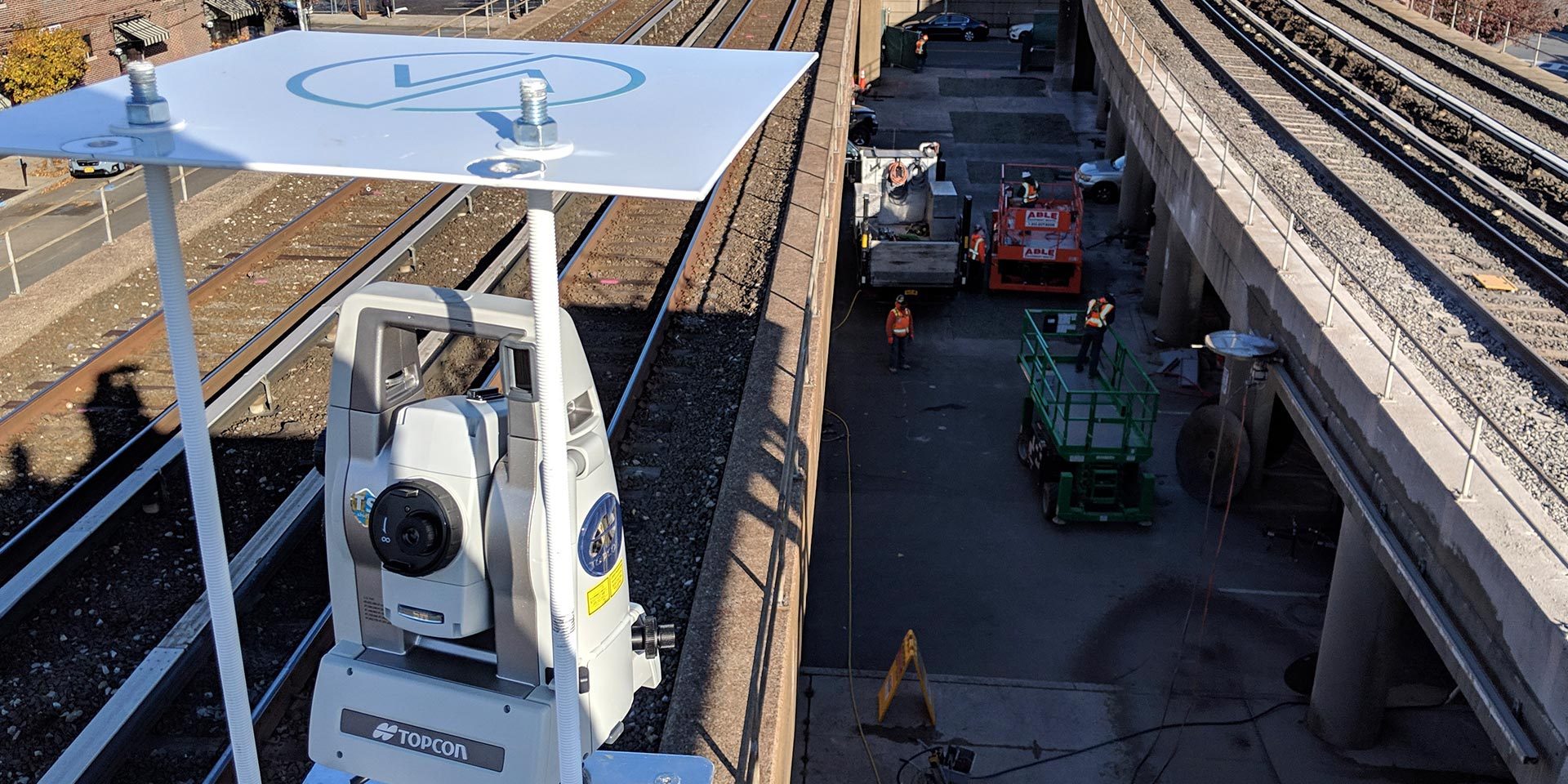Think of it as stealth construction.
On most major urban projects, long before the first bucket of dirt has been scooped, the first pile driven, even the first property corner verified, work, in the form of pre-construction survey and monitoring, has already been set in place. Critical for identifying existing conditions of adjacent properties before work begins, then monitoring those same properties — and others — for movement after startup, these facets can be as important to a design build team as the project itself.
In an ongoing project to add a third track to a ten-mile segment on the main corridor of the Long Island Rail Road (LIRR), Bronx, N.Y.-based Vibranalysis is undertaking that effort throughout the length of the $1.8 billion project.

Utilizing an arsenal of total stations, optical prisms, and an abundance of geotechnical, structural and environmental monitoring sensors, the company is helping ensure that the “before” picture is documented and any “after” events can be quickly identified and mitigated.
Working on the Railroad
The LIRR’s Main Line, which runs the length of the island from Long Island City, Queens to Greenport, Suffolk County — roughly 95 miles — carries about 40% of the railroad’s current 308,000 daily ridership.
A third track has been a subject of discussion since the 1940s but, for reasons ranging from fiscal concerns to resident complaints and everything in between, could never reach approval. Until this time around.
“More than a hundred thousand people depend on the LIRR’s Main Line on a daily basis — people who are affected by any interruption in train traffic along that 10-mile stretch,” said Howard Jameson, Vibranalysis’ vice president. “The expansion will be huge for improving service reliability on the line. However, this project covers a lot more than just the additional track, and we are providing instrumentation and monitoring services in several of those areas as well.”
Indeed, the list of improvements covered under a larger $2.6 billion cost umbrella is sizeable. It currently includes the elimination of seven grade crossings; seven bridge replacements and modifications; improvements at five passenger stations; replacement of seven electrical substations; improvements to existing parking facilities and construction of an entirely new parking ramp; and 7.5 miles of sound/retaining walls.
“Using monitoring gear on a job like this is essential,” said Jameson. “Anytime you are conducting an extensive scope of work adjacent to structures that are remaining active, you need to ensure that those structures react in the manner in which the way they are designed. And if they don’t, you need to be able to quantify that change and mitigate it immediately. We provide that level of information.”
While simple in practice, the science behind total station monitoring is actually very complex.
A permanently mounted total station measures angles and distances to optical prisms affixed to the structures being monitored. Software, bundled with the monitoring system, applies statistically-weighted adjustments to the measurements and outputs spatial coordinates for each prism. If the system notes a change in those coordinates, more than likely movement of the monitored subject has occurred. By comparing current and initially-gathered coordinates, the magnitude and direction of the movement can be determined.
Surviving Lean Times
Established more than three decades ago by Linda Socquet, Vibranalysis began as a provider of vibration monitoring services and pre-construction inspections — primarily for controlled-demolition applications.
“Linda Socquet started this business in mid-1980s in New York City — not the best time to be a woman in a startup construction-related business,” said Jameson. “But she was able to keep it going as a smaller, specialty firm focused on complex projects.
For example: in 1998, when The Empire Theater building in Times Square was physically moved to a new location about 168 feet away, she was responsible for instrumenting and monitoring that structure as it made the trip. Her drive and motivation has been a key motivator, not only for employees of this company, but for other leaders in the industry as well.
By his late teens, a growing interest in Vibranalysis led Jameson to programming and writing code that would prompt sensors to give results back through various logging pieces of hardware. “As I got older,” he added, “focusing on wireless systems, I learned more about the reasons for implementing specific sensors and the creative things you can do with them to overcome a challenging problem or situation.”
Armed with a degree and a vision for growing the business, Jameson joined Vibranalysis in 2012. Much like Linda Socquet decades before, he entered the business in challenging economic times; the New York City area was still recovering from The Great Recession. He quickly realized things were not going to be as easy as he’d initially thought.
“When I came onboard, business in the city was tough, especially with regard to new development,” he said. “At the time Linda had had about six employees, including office staff; essentially only three people in the field and a small fleet of equipment. However, after identifying a real need for technological advancement in our industry — and knowing we had the strengths to meet that need — we repositioned our firm as the region’s premier source for precision monitoring and analysis. That effort paid solid dividends in terms of new work and helped us get to where we are today.”
Total Monitoring Package
To gather the data needed to determine if construction is having an adverse effect on nearby assets, Vibranalysis is equipping each of the seven Main Line stations with a fully Automated Deformation Monitoring System (ADMS) from Topcon Positioning Systems called Delta-Solution. Delta-Solution is centered around an MS05AXII monitoring station which provides angular accuracies of 0.5”; reliable distance accuracy at 0.5 mm.
Delta-Solution also includes a Delta-Link controller which provides support for autonomous operation of the total station in the field, and offers communications options that include Ethernet, Wi-Fi, and a globally approved integrated cellular modem (data SIM provided by third parties).
To ensure uninterrupted operation and data transfer during any short power outages, Jameson’s team added a solar panel at each ADMS installation to complement the 110/240 VAC standard power supply and internal battery backup.
Data from the total stations are handled via Topcon’s Delta-Watch software which can process and analyze data individually or as a network solution. While Vibranalysis is obviously committed to the Topcon ADMS — they currently operate more than 15 systems — such was not always the case.
“Up until about a year and a half ago we were using a different solution for deformation monitoring,” said Jameson. “But a combination of cost and the fact that it had so many features we knew we’d never use, prompted us to talk to Topcon —we’ve never looked back since. For us, the Topcon system is all inclusive. After the fact I didn’t have to buy a $19,000 module for the adjustment software; I didn’t have to do any manual programming to control the gun via external modem and communications. Everything came in one package and that’s been a huge benefit for us.”
Committed to Prism
Seven individual stations along the line — Floral Park, New Hyde Park, Merillon Ave., Mineola Ave., Carle Place, Westbury and Hicksville — are also undergoing major renovations as part of the project, including construction of longer station platforms to accommodate full-length trains.
Vibranalysis will have ADMS packages located at each major work location, positioning components in a number of ways (on pedestals, poles, rooftops, abutments, etc.), depending on the specific need.
“This protocol will allow us to monitor the adjacent receptors to determine whether there is any construction-related movement or vibration that could potentially cause damage,” said Jameson. “We are conducting similar work near the Mineola station at the site of a new a new five-level, 550-space parking garage. There, we’ve mounted a pair of the MS05AXII total stations in enclosures atop stout, 10-foot high poles (for added security) and we will install optical prisms to monitor both the adjacent structures and the excavation’s SOE (support of excavation) wall.”
Efforts Paying Off
Since upping its game, Vibranalysis has been involved in some truly high-profile projects throughout the NYC metro area, including a 40-story project named “42 Trinity Place” in the financial district; the St. George Ferry Terminal on Staten Island; work associated with The High Line, a former elevated railway that has been repurposed into a 1.45 mile pedestrian greenway; and most recently, the massive TSX Broadway project which will eventually see the Palace Theater raised in its entirety some 35-feet to create additional retail space.
“We’ve worked hard to build this facet of the business and have been steadily seeing the fruits of those labors,” said Jameson. “In fact we recently landed several projects in the Los Angeles area which is not only a huge step forward for us, it’s an excellent opportunity to showcase our expertise to an entirely new market. We’re landing some great projects, we have outstanding people working for us — some of whom have been with the company for well over a decade — and our equipment has been effective, versatile, and extremely reliable. On the TSX project, we will be doing things that I think only three or four other firms like ours in the world can do. And we’re proud to be a part of projects like the LIRR expansion which will have a real, positive impact on so many people. I’d say we’re positioned exactly where we need to be.”
















